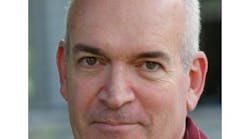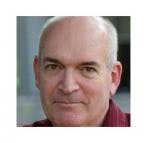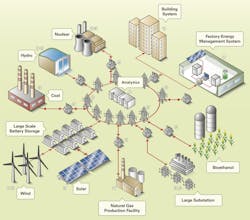While the goal of adding more solar and wind power to the generating mix has gotten a lot of attention, the consequence of that shift has not. Today, across the US, renewable sources other than hydro, account for just 7 percent of total generating capacity. But it is a percentage that is growing. Furthermore, other small power suppliers, including industrial companies that sometimes have spare power to return to the grid, are also growing in number. When coupled with an aging transmission infrastructure, demand that can vary significantly, especially with sudden changes in weather, and the often variable input of wind and solar sources, this mix of power generators can become very hard-to-manage.
And, when you are running an electric grid, there really isn’t much room for error, either a sudden excess or a shortage of current can trip breakers, damage transformers, or even cause blackouts.
That’s one of the ways that a “smart” grid can help. By providing detailed input from the demand (and the supply side), and combining that with analytics, electricity suppliers can get advanced warnings of changing conditions much earlier. Whether that’s hours or just seconds earlier, it can help tremendously to add or subtract generating capacity and reroute loads.
Even so, managing that for the whole grid will be very difficult.
That's why, few weeks ago, The Industrial Internet Consortium announced its first energy-focused testbed: the Communication and Control Testbed for Microgrid Applications. The goal of the Communication and Control Testbed is to introduce the flexibility of real-time analytics and control to increase efficiencies, ensuring that power is generated more accurately and reliably to match demand. Crucially, the focus is on a newly defined subunit of the grid. In essence this testbed proposes a form of isolation for newer and smaller generators, re-architecting electric power grids to include a series of distributed microgrids that will control smaller areas of demand with distributed generation and storage capacity. Although more independent, the microgrids will still interact and be coordinated with the existing infrastructure.
The Smart Microgrid. (Click to see larger image showing components from each participating company)
The testbed participants include Real-Time Innovations (RTI), National Instruments, and Cisco, as well as CPS Energy, Southern California Edison and the Smart Grid Interoperability Panel – (SGIP). They will work closely with Duke Energy, which recently published a distributed intelligence reference architecture, as well as with SGIP, to help ensure a coordinated, accepted architecture based on modern, “cross-industry” industrial internet technologies.
The Communications and Control framework will be developed in three phases. The initial phases will be tested in Southern California Edison's Controls Lab in Westminster, CA. Tests will culminate in a field deployment that will take place at CPS Energy's "Grid-of-the-Future" microgrid test area in San Antonio, Texas.
Stan Schneider, RTI's CEO, IIC Steering Committee member and member of the Smart Industry Advisory Board, explains that microgrids combine power sources at much faster update rates than traditional full-scale grids. They can use both solar and base generation, though they need some storage to work. He says utility-scale storage isn't practical [e.g. the so called spinning reserves of traditional generating sources held in reserve] while “tiny scale” such as a single home can work but is not very practical because the load (mostly at night) doesn't match the generation (only during the day). “Our solution is to build smaller, neighborhood or college campus or convention center-sized grids that include all the parts: base generation from the central power stations, solar, wind generation, and reasonable-sized storage,” says Schneider. To do that, you need things like fast control and networking and cheaper hardware; which is the aim of the testbed.
“Tesla recently also entered the market by offering battery storage. A big player like Tesla that could provide practical storage is exciting! Storage is today's weakest link. It will make our control and networking truly useful,” he adds. More thoughts on the topic can be found in Schneider’s blog post.
Alan R. Earls is a Boston-based writer focused on technology, business, and manufacturing — a field where he spent the earliest part of his career. He has written for publications and websites as diverse as The Boston Globe, Computerworld and Modern Infrastructure as well as Industry, The Manufacturer, and Today's Machining World.





